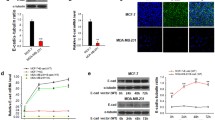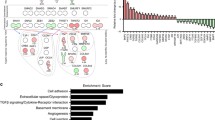Abstract
The recent report highlighted a significant association between signal transducer and activator of transcription 3 (STAT3) and Snail and LIV-1 (SLC39A6 or ZIP6), the breast cancer-associated protein that belongs to a new subfamily of zinc transporters. LIV-1 is a downstream target of STAT3, both in zebrafish and mammalian cells and provides control over epithelial-mesenchymal transition (EMT). Crucially, these observations link LIV-1, previously demonstrated to be associated with lymph node metastasis in breast cancer, to genes with a proven role in development. A putative role of LIV-1 as a regulator of E-cadherin that modulates the cell-cell adhesion is thus inferred. In present study, the correlation of LIV-1 and E-cadherin expression in human breast cancer cell MCF-7 and the effect of LIV-1 expression on the cell growth were assessed to explore the possible mechanisms associated with this observation in breast cancer. It was shown that the silencing of LIV-1 would induce the down-expression of E-cadherin. There was opposite results if the cells were overexpressed with LIV-1. In addition, the results showed that promotion effect after silencing of LIV-1 and inhibition effect after overexpression of LIV-1 in transfected cells. To our knowledge, this is the first evidence that the expression of E-cadherin could be regulated by the zinc transporter LIV-1. The results suggest that there is an association of LIV-1 expression with less aggressive tumors due to high E-cadherin expression because of high LIV-1 expression. LIV-1 may be a regulator of E-cadherin.




Similar content being viewed by others
Abbreviations
- STAT3:
-
Signal transducer and activator of transcription 3
- EMT:
-
Epithelial-mesenchymal transition
- ZIP:
-
Zrt-, Irt-like proteins
- LZT:
-
LIV-1 subfamily of ZIP zinc transporters
- RT-PCR:
-
Reverse transcription polymerase chain reaction
- MTT:
-
3-(4,5-Dimethylthiazol-2-yl)-2,5-diphenyl-2H-tetrazolium bromide
- MT:
-
Metallothioneins
- CDF:
-
Cation diffusion facilitator
References
Manning DL, Daly RJ, Lord PG et al (1988) Effects of oestrogen on the expression of a 4.4 kb mRNA in the ZR-75-1 human breast cancer cell line. Mol Cell Endocrinol 59:205–212
Manning DL, McClelland RA, Knowlden JM et al (1995) Differential expression of oestrogen regulated genes in breast cancer. Acta Oncol 34:641–646
McClelland RA, Manning DL, Gee JM et al (1998) Oestrogen-regulated genes in breast cancer: association of pLIV1 with response to endocrine therapy. Br J Cancer 77:1653–1656
Manning DL, Robertson JF, Ellis IO et al (1994) Oestrogen-regulated genes in breast cancer: association of pLIV1 with lymph node involvement. Eur J Cancer 30A:675–678
Taylor KM, Nichiolson RI (2003) The LZT proteins; the LIV-1 subfamily of zinc transporters. Biochim Biophys Acta 1611:16–30
Taylor KM, Morgan HE, Johnson A et al (2003) Structure-function analysis of LIV-1, the breast cancer-associated protein that belongs to a new subfamily of zinc transporters. Biochem J 375:51–59
Yamashita S, Miyagi C, Fukada T et al (2004) Zinc transporter LIVI controls epithelial-mesenchymal transition in zebrafish gastrula organizer. Nature 429:298–302
Taylor KM, Hiscox S, Nicholson RI (2004) Zinc transporter LIV-1: a link between cellular development and cancer progression. Trends Endocrinol Metab 15:461–463
Tuschl T (2002) Expanding small RNA interference. Nat Biotechnol 20:446–448
Zielske SP, Stevenson M (2005) Importin 7 may be dispensable for human immunodeficiency virus type 1 and simian immunodeficiency virus infection of primary macrophages. J Virol 79:11541–11546
Vallee BL, Auld DS (1990) Zinc coordination, function, and structure of zinc enzymes and other proteins. Biochemistry 29:5647–5659
Kagi JH, Valee BL (1960) Metallothionein: a cadmium- and zinc-containing protein from equine renal cortex. J Biol Chem 235:3460–3465
Cherian MG, Howell SB, Imura N et al (1994) Role of metallothionein in carcinogenesis. Toxicol Appl Pharmacol 126:1–5
Eide D (2004) The SLC39 family of metal ion transporters. Pflugers Arch 447:796–800
Kambe T, Yamaguchi-Iwai Y, Sasaki R et al (2004) Overview of mammalian zinc transporters. Cell Mol Life Sci 61:49–68
Kim SY, Kim JW, Ko YS et al (2003) Changes in lipid per oxidation and antioxidant trace elements in serum of women with cervical intraepithelial neoplasia and invasive cancer. Nutr Cancer 47:126–130
Tandon M, Kapil U, Bahadur S et al (2000) Role of micronutrients and trace elements in carcinoma of larynx. J Assoc Physicians India 48:995–998
Vallee BL, Falchuk KH (1993) The biochemical basis of zinc physiology. Physiol Rev 73:79–118
Shankar AH, Prasad AS (1998) Zinc and immune function, the biological basis of altered resistance to infection. Am J Clin Nutr 68:447–463
Barceloux DG (1999) Zinc. J Toxicol Clin Toxicol 37:279–292
Strain JJ (1994) Putative role of dietary trace element in coronary heart disease and cancer. Br J Biomed Sci 51:241–251
Navarro-Silvera SA, Rohan TE (2007) Trace elements and cancer risk: a review of the epidemiologic evidence. Cancer Causes Control 18:7–27
Cui Y, Vogt S, Olson N et al (2007) Levels of zinc, selenium, calcium, and iron in benign breast tissue and risk of subsequent breast cancer. Cancer Epidemiol Biomarkers Prev 16:1682–1685
Kasper G, Weiser AA, Rump A et al (2005) Expression levels of the putative zinc transporter LIV-1 are associated with a better outcome of breast cancer patients. Int J Cancer 117:961–973
Taylor KM, Morgan HE, Smart K et al (2007) The emerging role of the LIV-1 subfamily of zinc transporters in breast cancer. Mol Med 13:396–406
Shiozaki H, Oka H, Inoue M et al (1996) E-cadherin mediated adhesion system in cancer cells. Cancer 77:1605–1613
Bukholm IK, Nesland JM, Karesen R et al (1998) E-cadherin and α-, β-, and γ-catenin protein expression in relation to metastasis in human breast carcinoma. J Pathol 185:262–266
Van Aken E, De Wever O, Correia da Rocha AS et al (2001) Defective E-cadherin/catenin complexes in human cancer. Virchows Arch 439:725–751
Costello LC, Feng P, Milon B et al (2004) Role of zinc in the pathogenesis and treatment of prostate cancer: critical issues to resolve. Prostate Cancer Prostatic Dis 7:111–117
Costello LC, Franklin RB, Feng P (2005) Mitochondrial function, zinc, and intermediary metabolism relationships in normal prostate and prostate cancer. Mitochondrion 5:143–153
Costello LC, Franklin RB (2006) The clinical relevance of the metabolism of prostate cancer; zinc and tumor suppression: connecting the dots. Mol Cancer 5:17
Sun DX, Zhang LY,Wang YS et al (2007) Regulation of zinc transporters by dietary zinc supplement in breast cancer. Mol Biol Rep 34:241–247
Zhao L, Chen W, Taylor KM et al (2007) LIV-1 suppression inhibits HeLa cell invasion by targeting ERK1/2-Snail/Slug pathway. Biochem Biophys Res Commun 363:82–88
Ohkubo T, Ozawa M (2004) The transcription factor Snail downregulates the tight junction components independently of E-cadherin downregulation. J Cell Sci 117:1675–1685
Acknowledgments
We thank Dr. K. M. Taylor (Tenovus Cancer Research Centre, Welsh School of Pharmacy, Cardiff University, U.K.) for kindly providing us the LIV-1 recombinant. We also thank Dr. Qiuli Chen for her excellent technical assistance.
Author information
Authors and Affiliations
Corresponding author
Additional information
H. Shen and H. Qin are contributed equally to this work.
Rights and permissions
About this article
Cite this article
Shen, H., Qin, H. & Guo, J. Concordant correlation of LIV-1 and E-cadherin expression in human breast cancer cell MCF-7. Mol Biol Rep 36, 653–659 (2009). https://doi.org/10.1007/s11033-008-9225-4
Received:
Accepted:
Published:
Issue Date:
DOI: https://doi.org/10.1007/s11033-008-9225-4




